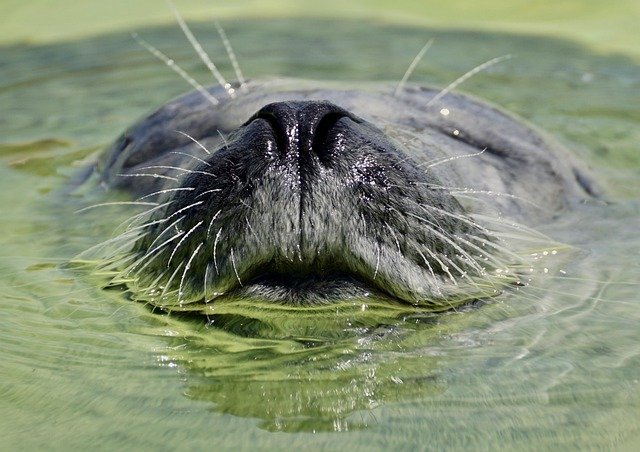Whiskers in the Wind: The Enigmatic World of Seal Whiskers
Seals, those charismatic marine mammals, have long captivated our imagination with their playful antics and soulful eyes. But beneath the surface lies a fascinating sensory marvel that's often overlooked: their whiskers. These seemingly simple structures are, in fact, highly sophisticated sensory organs that play a crucial role in a seal's survival. Join us as we dive into the enigmatic world of seal whiskers, exploring their incredible capabilities and the cutting-edge research that's unraveling their secrets.

The Evolution of Seal Whiskers
Seal whiskers have undergone millions of years of evolutionary refinement, adapting to the unique challenges of marine life. Unlike the whiskers of terrestrial mammals, seal vibrissae are highly specialized for underwater use. They’re typically longer, thicker, and more numerous than those of their land-dwelling counterparts.
The evolutionary journey of seal whiskers began when their ancestors first transitioned from land to sea. As these early pinnipeds adapted to an aquatic lifestyle, their whiskers became increasingly important for survival. Over time, natural selection favored individuals with more sensitive and numerous vibrissae, leading to the highly developed sensory system we see in modern seals.
The Anatomy of a Seal’s Supersensory Tool
Seal whiskers are marvels of biological engineering. Each vibrissa is embedded in a specialized follicle filled with blood vessels and nerve endings. This structure, known as a follicle-sinus complex, allows the whisker to detect even the slightest changes in water pressure and movement.
The whiskers themselves are not smooth but have a unique beaded or undulating structure. This peculiar shape helps to reduce drag as the seal swims, preventing the whiskers from bending backwards and ensuring they remain responsive to stimuli. The arrangement of whiskers on a seal’s face is also carefully optimized, with each vibrissa positioned to maximize sensory input from different directions.
The Superpower of Hydrodynamic Trail Detection
One of the most remarkable abilities of seal whiskers is their capacity for hydrodynamic trail detection. As fish and other marine creatures swim through the water, they leave behind a wake of tiny vortices and pressure changes. Seal whiskers are exquisitely sensitive to these hydrodynamic trails, allowing seals to track prey long after it has passed by.
Research has shown that seals can detect and follow these trails for several minutes after a fish has swum by, even in complete darkness or murky waters. This ability gives seals a significant advantage when hunting, allowing them to locate prey that would be otherwise invisible to them.
Whiskers as Navigation Tools
Beyond their role in prey detection, seal whiskers also serve as sophisticated navigation tools. As seals swim, their whiskers pick up information about water currents, obstacles, and even the seafloor topography. This sensory input helps seals build a three-dimensional map of their environment, allowing them to navigate complex underwater terrains with remarkable precision.
In the dynamic and often visually limited underwater world, this whisker-based navigation system is crucial for seals’ survival. It helps them avoid collisions, find their way back to breeding grounds, and locate suitable resting spots on the ocean floor.
Biomimicry: Learning from Nature’s Design
The extraordinary capabilities of seal whiskers haven’t gone unnoticed by scientists and engineers. In recent years, there’s been growing interest in mimicking the design and function of seal whiskers for various applications. This field, known as biomimicry, seeks to solve human challenges by emulating nature’s time-tested patterns and strategies.
Researchers are developing artificial whiskers inspired by those of seals for use in underwater robotics and sensing technologies. These bio-inspired sensors could revolutionize fields such as oceanography, underwater archaeology, and marine conservation. For instance, robotic submarines equipped with whisker-like sensors could navigate treacherous underwater environments more effectively, or detect subtle changes in ocean currents that might indicate climate change impacts.
The Future of Seal Whisker Research
As our understanding of seal whiskers continues to grow, so too does the potential for new discoveries and applications. Ongoing research is exploring how different seal species have adapted their whiskers to suit their specific habitats and hunting strategies. Scientists are also investigating how environmental changes, such as ocean acidification and rising temperatures, might affect the performance of seal whiskers.
The study of seal whiskers is not just about satisfying scientific curiosity; it has important implications for marine conservation. By understanding how seals use their whiskers to interact with their environment, we can better predict how these animals might respond to changes in their habitat. This knowledge is crucial for developing effective conservation strategies to protect these charismatic marine mammals in the face of global environmental challenges.
In conclusion, the humble seal whisker is a testament to the ingenuity of nature’s design. These remarkable sensory organs have allowed seals to thrive in the challenging marine environment for millions of years. As we continue to unravel the secrets of seal whiskers, we not only gain insights into the fascinating world of marine mammals but also find inspiration for innovative technologies that could help us explore and protect our oceans.





